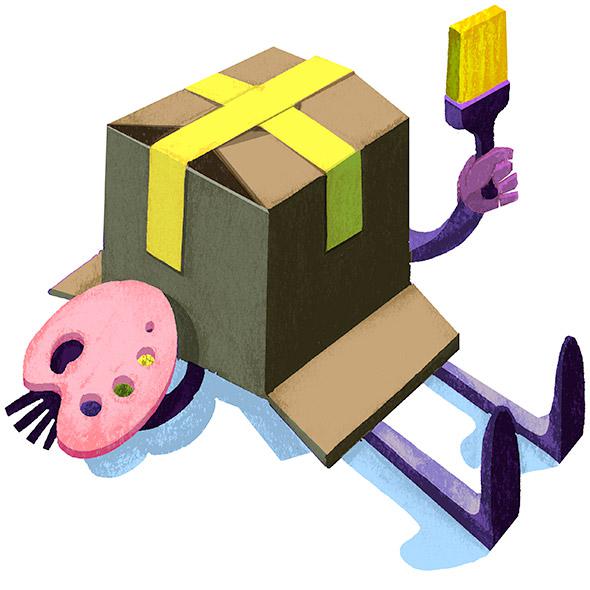In the United States we are raised to appreciate the accomplishments of inventors and thinkers—creative people whose ideas have transformed our world. We celebrate the famously imaginative, the greatest artists and innovators from Van Gogh to Steve Jobs. Viewing the world creatively is supposed to be an asset, even a virtue. Online job boards burst with ads recruiting “idea people” and “out of the box” thinkers. We are taught that our own creativity will be celebrated as well, and that if we have good ideas, we will succeed.
It’s all a lie. This is the thing about creativity that is rarely acknowledged: Most people don’t actually like it. Studies confirm what many creative people have suspected all along: People are biased against creative thinking, despite all of their insistence otherwise.
“We think of creative people in a heroic manner, and we celebrate them, but the thing we celebrate is the after-effect,” says Barry Staw, a researcher at the University of California–Berkeley business school who specializes in creativity.
Staw says most people are risk-averse. He refers to them as satisfiers. “As much as we celebrate independence in Western cultures, there is an awful lot of pressure to conform,” he says. Satisfiers avoid stirring things up, even if it means forsaking the truth or rejecting a good idea.
Even people who say they are looking for creativity react negatively to creative ideas, as demonstrated in a 2011 study from the University of Pennsylvania. Uncertainty is an inherent part of new ideas, and it’s also something that most people would do almost anything to avoid. People’s partiality toward certainty biases them against creative ideas and can interfere with their ability to even recognize creative ideas.
A close friend of mine works for a tech startup. She is an intensely creative and intelligent person who falls on the risk-taker side of the spectrum. Though her company initially hired her for her problem-solving skills, she is regularly unable to fix actual problems because nobody will listen to her ideas. “I even say, ‘I’ll do the work. Just give me the go ahead and I’ll do it myself,’ ” she says. “But they won’t, and so the system stays less efficient.”
In the documentary The September Issue, Anna Wintour systematically rejects the ideas of her creative director Grace Coddington, seemingly with no reason aside from asserting her power.
This is a common and often infuriating experience for a creative person. Even in supposedly creative environments, in the creative departments of advertising agencies and editorial meetings at magazines, I’ve watched people with the most interesting—the most “out of the box”—ideas be ignored or ridiculed in favor of those who repeat an established solution.
“Everybody hates it when something’s really great,” says essayist and art critic Dave Hickey. He is famous for his scathing critiques against the art world, particularly against art education, which he believes institutionalizes mediocrity through its systematic rejection of good ideas. Art is going through what Hickey calls a “stupid phase.”
In fact, everyone I spoke with agreed on one thing—unexceptional ideas are far more likely to be accepted than wonderful ones.
Staw was asked to contribute to a 1995 book about creativity in the corporate world. Fed up with the hypocrisy he saw, he called his chapter “Why No One Really Wants Creativity.” The piece was an indictment of the way our culture deals with new ideas and creative people:
In terms of decision style, most people fall short of the creative ideal … unless they are held accountable for their decision-making strategies, they tend to find the easy way out—either by not engaging in very careful thinking or by modeling the choices on the preferences of those who will be evaluating them.
Unfortunately, the place where our first creative ideas go to die is the place that should be most open to them—school. Studies show that teachers overwhelmingly discriminate against creative students, favoring their satisfier classmates who more readily follow directions and do what they’re told.
Even if children are lucky enough to have a teacher receptive to their ideas, standardized testing and other programs like No Child Left Behind and Race to the Top (a program whose very designation is opposed to nonlinear creative thinking) make sure children’s minds are not on the “wrong” path, even though adults’ accomplishments are linked far more strongly to their creativity than their IQ. It’s ironic that even as children are taught the accomplishments of the world’s most innovative minds, their own creativity is being squelched.
All of this negativity isn’t easy to digest, and social rejection can be painful in some of the same ways physical pain hurts. But there is a glimmer of hope in all of this rejection. A Cornell study makes the case that social rejection is not actually bad for the creative process—and can even facilitate it. The study shows that if you have the sneaking suspicion you might not belong, the act of being rejected confirms your interpretation. The effect can liberate creative people from the need to fit in and allow them to pursue their interests.
Perhaps for some people, the pain of rejection is like the pain of training for a marathon—training the mind for endurance. Research shows you’ll need it. Truly creative ideas take a very long time to be accepted. The better the idea, the longer it might take. Even the work of Nobel Prize winners was commonly rejected by their peers for an extended period of time.
Most people agree that what distinguishes those who become famously creative is their resilience. While creativity at times is very rewarding, it is not about happiness. Staw says a successful creative person is someone “who can survive conformity pressures and be impervious to social pressure.”
To live creatively is a choice. You must make a commitment to your own mind and the possibility that you will not be accepted. You have to let go of satisfying people, often even yourself.
